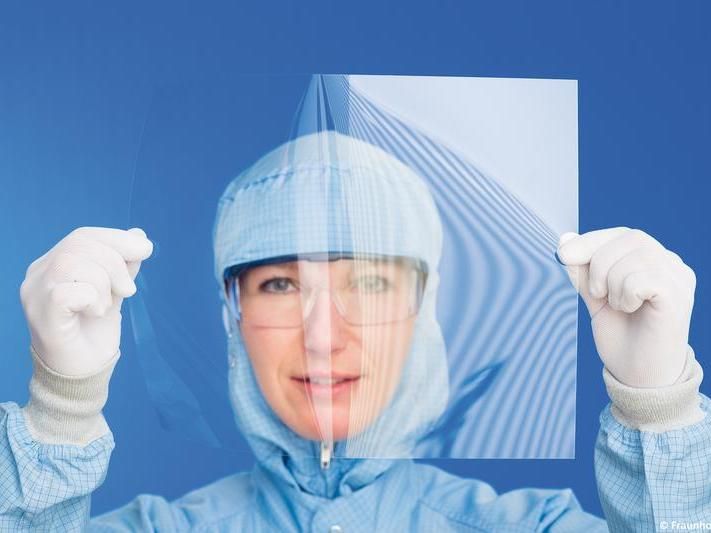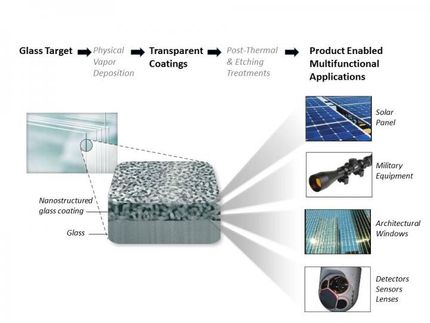New process for application-specific anti-reflective coatings
Whether eyewear, windshields, display windows or solar cells – nearly everyone uses products that reduce reflections without being aware of it. These kinds of anti-reflective coatings provide on one hand crystal-clear viewing and on the other are able to capture nearly all the sunlight falling on solar cells coated this way, since there is practically no reflection on the surface.
These coatings, while hardly visible to users, offer a different kind of challenge to scientists when applied to various substrates like plastic films and rigid or flexible glass. The main focus when coating the substrate is to develop a coating process that is economical and can match the properties of the layers to the purpose of the specific application.
The researchers at Fraunhofer FEP have now tested a novel technology for creating anti-reflective coatings on glass. In a first step a gradient layer consisting of silicon dioxide (SiO2) and an additional supplementary component are deposited by means of a co-sputtering process. In a following process step the supplementary component is removed by an etching process. The result is a remnant layer of rough silicon dioxide. Thanks to the resultant continuous transition in optical properties from air to glass, anti-reflective behavior is exhibited by the surface of the glass.
A similar effect is offered by Fraunhofer FEP through its PolAR process for making plastic sheets or web anti-reflective. This process was originally developed jointly with Fraunhofer IOF and industrial partners. It nanoetches the surface of polymers directly by means of a plasma. The gradual transition in refractive index from air to polymer achieved this way is likewise anti-reflective.
In a conventional anti-reflective coating, layers of high and low refractive index are deposited of alternately. The disadvantage of this approach is the restricted wavelength range that its anti-reflective effect is confined to. The width of the range can only be broadened by use of a complex system of interferring layers. In contrast, anti-reflective coating systems based on effects caused by rough surfaces have no sharply defined wavelength restriction to their anti-reflective properties. This allows the prevention of reflection over a wide spectral range by coating with a single layer or a single plasma etching step, respectively. The color of the layers is also quite neutral.
“The layers achieved with the new process are characterized by a good mechanical durability and the reduction of reflections over a wide spectral range,” explains Thomas Preußner, researcher for large-area in-line processing at Fraunhofer FEP.
Anti-reflective coatings are only one application example for the described novel co-sputtered method. The technology has demonstrated the feasibility for producing rough layers thus having the possibility to be applied in additional kinds of applications. It offers the potential of making battery and solar-cell electrodes larger and more effective through the use of rough layers, for example.
The comprehensive scientific know-how and proto-industrial facilities at Fraunhofer FEP enable specialized anti-reflective coatings to be developed in cooperation with clients matching their specific applications.

Glass with an anti-reflection coating
Fraunhofer FEP, Fotograf: Jürgen Lösel
Other news from the department science
These products might interest you

OCA 200 by DataPhysics
Using contact angle meter to comprehensively characterise wetting behaviour, solids, and liquids
With its intuitive software and as a modular system, the OCA 200 answers to all customers’ needs

Tailor-made products for specific applications by IPC Process Center
Granulates and pellets - we develop and manufacture the perfect solution for you
Agglomeration of powders, pelletising of powders and fluids, coating with melts and polymers

Dursan by SilcoTek
Innovative coating revolutionizes LC analysis
Stainless steel components with the performance of PEEK - inert, robust and cost-effective

Get the chemical industry in your inbox
By submitting this form you agree that LUMITOS AG will send you the newsletter(s) selected above by email. Your data will not be passed on to third parties. Your data will be stored and processed in accordance with our data protection regulations. LUMITOS may contact you by email for the purpose of advertising or market and opinion surveys. You can revoke your consent at any time without giving reasons to LUMITOS AG, Ernst-Augustin-Str. 2, 12489 Berlin, Germany or by e-mail at revoke@lumitos.com with effect for the future. In addition, each email contains a link to unsubscribe from the corresponding newsletter.




























































